| Article ID | Journal | Published Year | Pages | File Type |
|---|---|---|---|---|
| 5020040 | Additive Manufacturing | 2017 | 20 Pages |
Abstract
Lack-of-fusion flaws can occur in powder bed fusion (PBF) additive manufacturing of metal components. This paper demonstrates a method for detecting such flaws by monitoring the fabrication of every layer before and after laser scanning with high resolution optical imaging. A binary template is created from the sliced 3D model of the part. Using this template the optical image data is indexed to the part geometry. The indexed image data is used to detect anomalies in the powder layer before laser scanning and in the solidified material after scanning. Lack-of-fusion defects are identified from optical data by correlating multiple images with different lighting conditions and from multiple layers. To test the algorithms intentional defects are created inside a test part at different locations and are successfully detected with a high true positive rate.
Related Topics
Physical Sciences and Engineering
Engineering
Industrial and Manufacturing Engineering
Authors
Mostafa Abdelrahman, Edward W. Reutzel, Abdalla R. Nassar, Thomas L. Starr,
